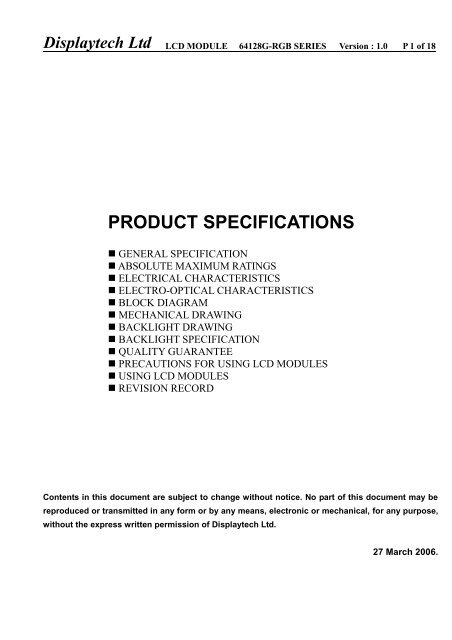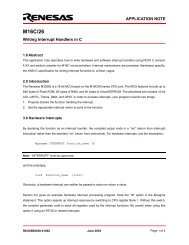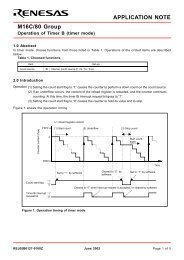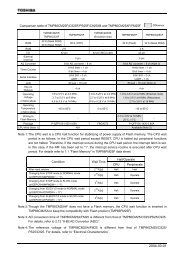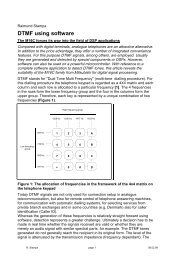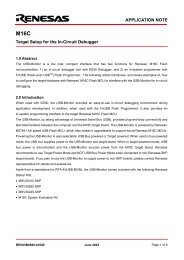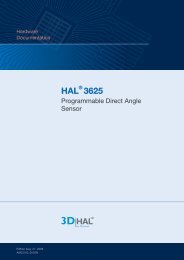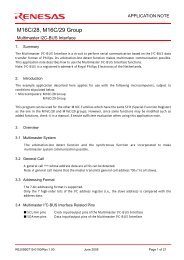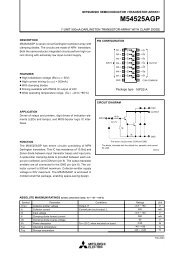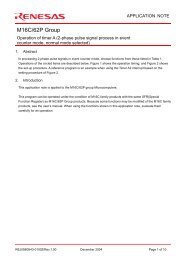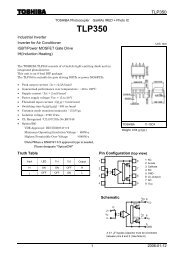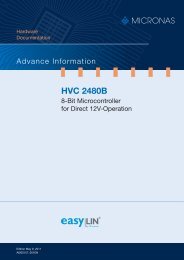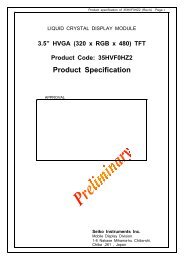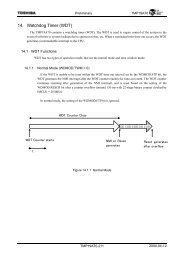Displaytech Ltd LCD MODULE 64128G-RGB SERIES - Glyn
Displaytech Ltd LCD MODULE 64128G-RGB SERIES - Glyn
Displaytech Ltd LCD MODULE 64128G-RGB SERIES - Glyn
Create successful ePaper yourself
Turn your PDF publications into a flip-book with our unique Google optimized e-Paper software.
<strong>Displaytech</strong> <strong>Ltd</strong> <strong>LCD</strong> <strong>MODULE</strong> <strong>64128G</strong>-<strong>RGB</strong> <strong>SERIES</strong> Version : 1.0 P 3 of 18•ELECTRO-OPTICAL CHARACTERISTICSNO Item Symbol12RecommendedOperatingVoltageOperatingVoltage3 Response time45ViewingAngle (Cr2)CurrentConsumptionV<strong>LCD</strong>MeasuringSTD.ValueCondition C Min Typ Max= 0= 0 25 8.7 9 9.3Vth0 --- --- ---= 025 --- 1.869 ---= 050 --- --- ---Vsat0 --- --- ---= 025 --- 2.016 ---= 050 --- --- ---Tr0 --- --- ---= 025 --- 55 ---= 1050 --- --- ---Tf0 --- --- ---= 025 --- 115 ---= 1050 --- --- --- =0° 25 --- 40 --- =180° 25 --- 35 --- =90° 25 --- 30 --- =270° 25 --- 30 ---UnitVmsDegRemarkNote1Note2Note4Note1I<strong>LCD</strong> Hz=64 25 --- 15 --- uA Note3NOTE 1:DEFINITION OF VIEWING ANGLE AND DIRECTION12H =180 °Z=0 °Detector3H =90 °9H =270 °6H =0 °NOTE 2:THERSHOLD VOLTAGE AND SATURATION VOLTAGEVth: The voltage Vop which the transmission rate of segment is 90%(positive) or 10%(negative) of saturated value on conditionsof the selected waveform.(non-selected waveform is opposition)Vsat: The voltage Vop which the transmission rate of segment is 10%(positive) or 10%(negative) of saturated value onconditions of the selected waveform.(non-selected waveform is opposition)
<strong>Displaytech</strong> <strong>Ltd</strong> <strong>LCD</strong> <strong>MODULE</strong> <strong>64128G</strong>-<strong>RGB</strong> <strong>SERIES</strong> Version : 1.0 P 7 of 18•BACKLIGHT DRAWING
<strong>Displaytech</strong> <strong>Ltd</strong> <strong>LCD</strong> <strong>MODULE</strong> <strong>64128G</strong>-<strong>RGB</strong> <strong>SERIES</strong> Version : 1.0 P 8 of 18•BACKLIGHT SPECIFICATIONMECHANICAL SPECIFICATIONSITEM NOMINAL DIMENSIONS UNITOUTLINE SIZE (LxWxH) 58.20 x 41.70 x 8.50 mmVIEWING AREA (LxW) 52.00 x 27.00 mmCONTACT PIN PITCH/LENGTH NIL mmNO.OF LED SMT 3 ---ELECTRICAL/OPTICAL CHARACTERISTICS (Ta=25 C, If=60mA typ.)MODE PARAMETER UNITCOLORREDPUREGREENBLUE ---CHROMATICITY COORDINATEX=0.6966 X=0.1982 X=0.1411Y=0.3024 Y=0.7234 Y=0.0584---FORWARD VOLTAGE (Vf) 3.2 typ 3.2 typ 3.2 typ VFORWARD CURRENT (If) 60 60 60 mAAVERAGE LUMINOUS INTENSITY (Iv) 30 170 70 cd/m 2ABSOLUTE MAXIMUM RATINGITEMREDPUREGREENBLUE UNITFORWARD CURRENT 90mA 90mA 90mA IfREVERSE VOLTAGE 5V 5V 5V VrPOWER DISSIPATION 288mW 288mW 288mW PdOPERATING TEMPERATURE -20C TO 70C TopSTORAGE TEMPERATURE -30C TO 80C TstgTESTING POINTCIRCUIT DIAGRAMREMARK:1. AVERAGE LUMINOUS INTENSITY IS THE AVERAGE VALUE OF THE NINE INDICATED POINTS ASSHOWN.2. MEASUREMENT INSTRUMENT: BM-7, APERTURE: 10mm.
<strong>Displaytech</strong> <strong>Ltd</strong> <strong>LCD</strong> <strong>MODULE</strong> <strong>64128G</strong>-<strong>RGB</strong> <strong>SERIES</strong> Version : 1.0 P 9 of 18•QUALITY GUARANTEEPURPOSE:It is to define the inspection standard of <strong>LCD</strong> modulesPRODUCT STANDARD1) INSPECTION AND TEST FUNCTION TEST APPEARANCE INSPECTION PACKING SPECIFICTION2) INSPECTION CONDITION Put under the lamp (20w×2) at a distance 100mm from the <strong>LCD</strong> Modules. Tilt upright 45 degree by the front (back) to inspect <strong>LCD</strong> appearance.3) AQL INSPECTION LEVEL SAMPLING METHOD : MIL-STD-105D SAMPLING PLAN : SINGLE MAJOR DEFECT : 0.65% (MAJOR) MINOR DEFECT : 2.5% (MINOR) GENERAL LEVEL : II/NORMALLCMLAMPOPERATORDISPLAY AREA DEFINITION:ViewareaViewingboundary
<strong>Displaytech</strong> <strong>Ltd</strong> <strong>LCD</strong> <strong>MODULE</strong> <strong>64128G</strong>-<strong>RGB</strong> <strong>SERIES</strong> Version : 1.0 P 10 of 18INSPECTION STANDARD1) FUNCTIONAL TEST STANDARDItem Inspection Standard Description Standard Defect type1 <strong>LCD</strong> has no display Reject MAJ2 LCM display do not change Reject MAJ3 Display wrong pattern Reject MAJMissing4 Display segment open segmentReject MAJMissingsegment5 Display dim segment DimReject MAJsegmentDimsegment6 Wrong <strong>LCD</strong> viewing direction Reject MAJ7 Dim DisplaySeesampleMAJ8 <strong>LCD</strong> color variationSeesampleMAJPattern parallelismAcceptable rangeL 0.25 1 AcceptØ41 W 1 Reject MIN
<strong>Displaytech</strong> <strong>Ltd</strong> <strong>LCD</strong> <strong>MODULE</strong> <strong>64128G</strong>-<strong>RGB</strong> <strong>SERIES</strong> Version : 1.0 P 11 of 18Item Inspection Standard Description Standard Defect typeDrawStandardX y QTY≧41 b ≧41 a 1 Reject MIN11<strong>LCD</strong> displayBroken segment(dots)(X or y) ≧0.2mm 1 Reject MIN≦41 b ≦41 a 1 Accept≦51 b ≦51 a 2 Accept12<strong>LCD</strong> displayBlack spot orWhite spotØ=x y2QTYØ0.025) 0 Reject MAJ14 Backlight not function Reject MAJ15 LED not function or dim Reject MIN16 Backlight defect (dirt, scratch) Reject MIN2) COSMETIC INSPECTION STANDARDItem Standard description of inspection Standard Defect type1 <strong>LCD</strong> inspection item1.1 <strong>LCD</strong> color variationSeesampleMIN1.2 <strong>LCD</strong> broken Reject MAJ1.3 Wrong polarizer of <strong>LCD</strong> Reject MAJ1.4 Spot on <strong>LCD</strong> surface Reject MAJScratch on <strong>LCD</strong>Scratch = Ø QTYxØ0.25 1 Reject MIN1.6<strong>LCD</strong> scratchScratch =L scratch =W QTYW≦0.015Accept
<strong>Displaytech</strong> <strong>Ltd</strong> <strong>LCD</strong> <strong>MODULE</strong> <strong>64128G</strong>-<strong>RGB</strong> <strong>SERIES</strong> Version : 1.0 P 12 of 18Item Standard description of inspection Standard Defect typeBlack line in <strong>LCD</strong>(L) (W) QTYL≦1.0 W≦0.025 2 Accept1.81.06.0mm >1.5mm Reject MIN2.4 Damage excess 2x2mm at the PCB corner Reject MIN2.5 Scratch on PCB surface See sample MIN2.6 Scratch on PCB coat/leakage coat on PCB surface Reject MAJ2.7 Open circuit Reject MAJ2.8 PCB PTH open Reject MAJ2.9 Repair PCB PTHQTY≦2PCS AcceptQTY≧3PCS Reject MAJ2.10 Color different from one side to another side. Reject MIN2.11 Repaired solder mask area≦30mm 2 Accept≧30mm 2 Reject MINScratch circuit, damageCircuita≦1/2w or b1/2w or b>wReject3 Bezel specification3.1 Wrong Materials MAJ3.2 Incorrect dimension MAJ3.3 Bezel broken MAJ3.4 Rust on Bezel MAJSizecm 2 /perØ≦0.3 2 Accept3.5Hole or dirty on oilPaint surfaceTop surfaceSide0.30.5 0 Reject MINØ≦0.5 2 Accept0.50.8 0 Reject MIN
<strong>Displaytech</strong> <strong>Ltd</strong> <strong>LCD</strong> <strong>MODULE</strong> <strong>64128G</strong>-<strong>RGB</strong> <strong>SERIES</strong> Version : 1.0 P 13 of 18Item Standard description of inspection Standard Defect typeh≦0.01 mm/mm Accept3.6 Bezel bow or twisth>0.01 mm/mm Reject MIN3.7d1-d2≦toleranceAccept3.8Scratch on bezeld1-d2>tolerance Reject MINFaceAcceptQTYL W Not- W≦0.15 definedSeeL≦3 W≦0.20 2SampleL≦2 W≦0.3 2- W>0.3sideLWAcceptQTY- W≦0.2 exceptL≦3 W≦0.25 2L≦2 W≦0.3 2SeeSample3.9 Twist angle α=45º+5º Accept3.10 Void gap between bezel and PCB Reject MINBezel clip incorrectly3.11RejectMIN4 Solder specification4.1 Wrong component Reject MAJ4.2 Broken component Reject MAJComponent legs extend beyond the pad andMis-alignmentLegs >pad distance(w) on solder area >W 2 AcceptNG4.3ComponentOffsetComponent assembly defectComponent legs extend beyond the pad andLegs >pad distance(w) on solder area 0.5mm Reject MIN
<strong>Displaytech</strong> <strong>Ltd</strong> <strong>LCD</strong> <strong>MODULE</strong> <strong>64128G</strong>-<strong>RGB</strong> <strong>SERIES</strong> Version : 1.0 P 14 of 18Item Standard description of inspection Standard Defect type4.7 Components hoisth≦2.0mm Accepth>2.0mm Reject MIN4.8 Switch (socket) hoisth≦0.5mm Accepth>0.5mm Reject MIN4.9 Components cold solder or incomplete solder Reject MAJSolder PAD tilt up, but height (h) less thanSolder PAD thickness (a)4.10AcceptExcess solder above components4.11RejectMinInsufficient solder belowcomponents height or less than diameter4.12RejectMIN4.13 Solder area less than soldering PAD Area by 2/3 Reject MINTrimmed pin length beyond 0.09inch (2.3mm)4.14RejectMin5 Packing specification5.1 Wrong carton mark . Reject MAJ5.2 Carton mark problem Reject MIN5.3 Carton damage extend than 150mm Reject MAJ5.4 Carton damage, scratch more 50mm, less 150mm. Reject MIN
<strong>Displaytech</strong> <strong>Ltd</strong> <strong>LCD</strong> <strong>MODULE</strong> <strong>64128G</strong>-<strong>RGB</strong> <strong>SERIES</strong> Version : 1.0 P 15 of 18•PRECAUTIONS FOR USING <strong>LCD</strong> <strong>MODULE</strong>SHANDLING PRECAUTIONS1. This device is susceptible to Electro-Static Discharge (ESD) damage. Observe Anti-Static precautions.2. The display panel is made of glass. Do not subject it to a mechanical shock by dropping it or impact.3. If the display panel is damaged and the liquid crystal substance leaks out, be sure not to get any in your mouth. If thesubstance contacts your skin or clothes, wash it off using soap and water.4. Do not apply excessive force to the display surface or the adjoining areas since this may cause the color tone to vary.5. The polarizer covering the display surface of the <strong>LCD</strong> module is soft and easily scratched. Handle this polarizer carefully.6. If the display surface becomes contaminated, breathe on the surface and gently wipe it with a soft dry cloth. If it is heavilycontaminated, moisten cloth with one of the following solvents : Isopropyl alcohol Ethyl alcohol7. Solvents other than those above-mentioned may damage the polarizer. Especially, do not use the following. Water Ketone Aromatic solvents8. Exercise care to minimize corrosion of the electrode. Corrosion of the electrodes is accelerated by water droplets, moisturecondensation or a current flow in a high-humidity environment.9. Install the <strong>LCD</strong> Module by using the mounting holes. When mounting the <strong>LCD</strong> module make sure it is free of twisting,warping and distortion. In particular, do not forcibly pull or bend the IO cable or the backlight cable.10. Do not attempt to disassemble or process the <strong>LCD</strong> module.11. NC terminal should be open. Do not connect anything.12. If the logic circuit power is off, do not apply the input signals.13. To prevent destruction of the elements by static electricity, be careful to maintain an optimum work environment. Be sure to ground the body when handling the <strong>LCD</strong> modules. Tools required for assembling, such as soldering irons, must be properly grounded. To reduce the amount of static electricity generated, do not conduct assembling and other work under dry conditions. The <strong>LCD</strong> module is coated with a film to protect the display surface. Exercise care when peeling off this protective filmsince static electricity may be generated.POWER SUPPLY PRECAUTIONS:1. Identify and, at all times, observe absolute maximum ratings for both logic and LC drivers. Note that there is some variancebetween models.2. Prevent the application of reverse polarity to VDD and VSS, however briefly.3. Use a clean power source free from transients. Power-up conditions are occasionally“jolting”and may exceed the maximumratings of the modules.4. The VDD power of the module should also supply the power to all devices that may access the display. Don’t allow the databus to be driven when the logic supply to the module is turned off.5. DO NOT install a capacitor between the VO (contrast) pin and ground. VDD must, at all times, exceed the VO voltage level.The capacitor combines with the contrast potentiometer to form an R-C network which“holds-up”VO, at power-down,possibly damaging the module.OPERATING PRECAUTIONS:1. DO NOT plug or unplug the module when the system is powered up.2. Minimize the cable length between the module and host MPU.3. For models with EL backlights, do not disable the backlight by interrupting the HV line. Unload inverters produce voltageextremes that may arc within a cable or at the display.4. Operate the module within the limits of the modules temperature specifications.MECHANICAL/ENVIRONMENTAL PRECAUTIONS:1. Improper soldering is the major cause of module difficulty. Use of flux cleaner is not recommended as they may seep underthe elastomeric connection and cause display failure.2. Mount the module so that it is free from torque and mechanical stress.3. Surface of the <strong>LCD</strong> panel should not be touched or scratched. The display front surface is an easily scratched, plasticpolarizer. Avoid contact and clean only when necessary with soft, absorbent cotton dampened with petroleum benzene.4. Always employ anti-static procedure while handling the module.5. Prevent moisture build-up upon the module and observe the environmental constraints for storage temperature and humidity.
<strong>Displaytech</strong> <strong>Ltd</strong> <strong>LCD</strong> <strong>MODULE</strong> <strong>64128G</strong>-<strong>RGB</strong> <strong>SERIES</strong> Version : 1.0 P 16 of 186. Do not store in direct sunlight7. If leakage of the liquid crystal material should occur, avoid contact with this material, particularly ingestion. If the bodyor clothing becomes contaminated by the liquid crystal material, wash thoroughly with water and soapStorage PrecautionsWhen storing the <strong>LCD</strong> modules, avoid exposure to direct sunlight or to the light of fluorescent lamps. Keep the modules inbags (avoid high temperature high humidity and low temperatures below 0C). Whenever possible, the <strong>LCD</strong> modules should bestored in the same conditions in which they were shipped from our company.OthersLiquid crystals solidify under low temperature (below the storage temperature range) leading to defective orientation or thegeneration of air bubbles (black or white). Air bubbles may also be generated if the module is subject to a low temperature.If the <strong>LCD</strong> modules have been operating for a long time showing the same display patterns, the display patterns mayremain on the screen as ghost images and a slight contrast irregularity may also appear. A normal operating status can be regainedby suspending use for some time. It should be noted that this phenomenon does not adversely affect performance reliability.To minimize the performance degradation of the <strong>LCD</strong> modules resulting from destruction caused by static electricity etc.,exercise care to avoid holding the following sections when handling the modules. Exposed area of the printed circuit board. Terminal electrode sections.•USING <strong>LCD</strong> <strong>MODULE</strong>SLiquid Crystal Display Modules<strong>LCD</strong> is composed of glass and polarizer. Pay attention to the following items when handling.1. Please keep the temperature within specified range for use and storage. Polarization degradation, bubble generation orpolarizer peel-off may occur with high temperature and high humidity.2. Do not touch, push or rub the exposed polarizers with anything harder than an HB pencil lead (glass, tweezers, etc.).3. N-hexane is recommended for cleaning the adhesives used to attach front/rear polarizers and reflectors made of organicsubstances which will be damaged by chemicals such as acetone, toluene, ethanol and isopropylalcohol.4. When the display surface becomes dusty, wipe gently with absorbent cotton or other soft material like chamois soaked inpetroleum benzin. Do not scrub hard to avoid damaging the display surface.5. Wipe off saliva or water drops immediately, contact with water over a long period of time may cause deformation or colorfading.6. Avoid contacting oil and fats.7. Condensation on the surface and contact with terminals due to cold will damage, stain or dirty the polarizers. After productsare tested at low temperature they must be warmed up in a container before coming is contacting with room temperature air.8. Do not put or attach anything on the display area to avoid leaving marks on.9. Do not touch the display with bare hands. This will stain the display area and degradate insulation between terminals (somecosmetics are determinated to the polarizers).10. As glass is fragile. It tends to become or chipped during handling especially on the edges. Please avoid dropping or jarring.Installing <strong>LCD</strong> ModulesThe hole in the printed circuit board is used to fix LCM as shown in the picture below. Attend to the following items wheninstalling the LCM.1. Cover the surface with a transparent protective plate to protect the polarizer and LC cell.2. When assembling the LCM into other equipment, the spacer to the bit between the LCM and the fitting plate should haveenough height to avoid causing stress to the module surface, refer to the individual specifications for measurements. Themeasurement tolerance should be 0.1mm.
<strong>Displaytech</strong> <strong>Ltd</strong> <strong>LCD</strong> <strong>MODULE</strong> <strong>64128G</strong>-<strong>RGB</strong> <strong>SERIES</strong> Version : 1.0 P 17 of 18Precaution for Handing <strong>LCD</strong> ModulesSince LCM has been assembled and adjusted with a high degree of precision, avoid applying excessive shocks to themodule or making any alterations or modifications to it.1. Do not alter, modify or change the the shape of the tab on the metal frame.2. Do not make extra holes on the printed circuit board, modify its shape or change the positions of components to be attached.3. Do not damage or modify the pattern writing on the printed circuit board.4. Absolutely do not modify the zebra rubber strip (conductive rubber) or heat seal connector.5. Except for soldering the interface, do not make any alterations or modifications with a soldering iron.6. Do not drop, bend or twist LCM.Electro-Static Discharge ControlSince this module uses a CMOS LSI, the same careful attention should be paid to electrostatic discharge as for an ordinaryCMOS IC.1. Make certain that you are grounded when handing LCM.2. Before remove LCM from its packing case or incorporating it into a set, be sure the module and your body have the sameelectric potential.3. When soldering the terminal of LCM, make certain the AC power source for the soldering iron does not leak.4. When using an electric screwdriver to attach LCM, the screwdriver should be of ground potentiality to minimize as much aspossible any transmission of electromagnetic waves produced sparks coming from the commutator of the motor.5. As far as possible make the electric potential of your work clothes and that of the work bench the ground potential.6. To reduce the generation of static electricity be careful that the air in the work is not too dried. A relative humidity of50%-60% is recommended.Precaution for soldering to the LCM1. Observe the following when soldering lead wire, connector cable and etc. to the LCM. Soldering iron temperature : 280C 10C. Soldering time : 3-4 sec. Solder : eutectic solder.If soldering flux is used, be sure to remove any remaining flux after finishing to soldering operation. (This does not applyin the case of a non-halogen type of flux.) It is recommended that you protect the <strong>LCD</strong> surface with a cover during soldering toprevent any damage dur to flux spatters.2. When soldering the electroluminescent panel and PC board, the panel and board should not be detached more than threetimes. This maximum number is determined by the temperature and time conditions mentioned above, though there may besome variance depending on the temperature of the soldering iron.3. When remove the electoluminescent panel from the PC board, be sure the solder has completely melted, the soldered pad onthe PC board could be damaged.Precautions for Operation1. Viewing angle varies with the change of liquid crystal driving voltage (VO). Adjust VO to show the best contrast.2. Driving the <strong>LCD</strong> in the voltage above the limit shortens its life.3. Response time is greatly delayed at temperature below the operating temperature range. However, this does not mean the<strong>LCD</strong> will be out of the order. It will recover when it returns to the specified temperature range.4. If the display area is pushed hard during operation, the display will become abnormal. However, it will return to normal if itis turned off and then back on.5. Condensation on terminals can cause an electrochemical reaction disrupting the terminal circuit. Therefore, it must be usedunder the relative condition of 40C , 50% RH.6. When turning the power on, input each signal after the positive/negative voltage becomes stable.
<strong>Displaytech</strong> <strong>Ltd</strong> <strong>LCD</strong> <strong>MODULE</strong> <strong>64128G</strong>-<strong>RGB</strong> <strong>SERIES</strong> Version : 1.0 P 18 of 18StorageWhen storing <strong>LCD</strong>s as spares for some years, the following precaution are necessary.1. Store them in a sealed polyethylene bag. If properly sealed, there is no need for dessicant.2. Store them in a dark place. Do not expose to sunlight or fluorescent light, keep the temperature between 0C and 35C.3. The polarizer surface should not come in contact with any other objects. (We advise you to store them in the container inwhich they were shipped.)4. Environmental conditions : Do not leave them for more than 168hrs. at 60C. Should not be left for more than 48hrs. at -20C.Safety1. It is recommended to crush damaged or unnecessary <strong>LCD</strong>s into pieces and wash them off with solvents such as acetone andethanol, which should later be burned.2. If any liquid leakes out of a damaged glass cell and comes in contact with the hands, wash off thoroughly with soap andwater.Limited WarrantyUnless agreed between DISPLAYTECH and customer, DISPLAYTECH will replace or repair any of its <strong>LCD</strong> moduleswhich are found to be functionally defective when inspected in accordance with DISPLAYTECH <strong>LCD</strong> acceptance standards(copies available upon request) for a period of one year from date of shipments. Cosmetic/visual defects must be returned toDISPLAYTECH within 90 days of shipment. Confirmation of such date shall be based on freight documents. The warrantyliability of DISPLAYTECH limited to repair and/or replacement on the terms set forth above. DISPLAYTECH will not beresponsible for any subsequent or consequential events.Return LCM under warrantyNo warranty can be granted if the precautions stated above have been disregarded. The typical examples of violations are : Broken <strong>LCD</strong> glass.PCB eyelet’s damaged or modified. PCB conductors damaged. Circuit modified in any way, including addition of components. PCB tampered with by grinding, engraving or painting varnish. soldering to or modifying the bezel in any manner.Module repairs will be invoiced to the customer upon mutual agreement. Modules must be returned with sufficientdescription of the failures or defects. Any connectors or cable installed by the customer must be removed completely withoutdamaging the PCB eyelet’s, conductors and terminals.•REVISION RECORDVERSION CHANGES DATE1.0 Initial revision 27 Mar. 2006


